Contributory members are able to log private notes and comments about each site
Sites Anne T has logged. View this log as a table or view the most recent logs from everyone
Corbridge Crosses
Trip No.149 Entry No.2 Date Added: 12th Sep 2019
Site Type: Ancient Cross
Country: England (Northumberland)
Visited: Yes on 8th Sep 2019. My rating: Condition 3 Ambience 4 Access 5

Corbridge Crosses submitted by Anne T on 12th Sep 2019. The old market cross, which stood upon steps and a Roman altar, was removed from it's original place in 1807, and stood outside the Roman Catholic Cathedral in Newcastle. It was returned to Corbridge in the 20th century, but now sits 2m to the east of the door into the Pele Tower. Very worn, it once had an inscription, plus dog tooth ornament.
(View photo, vote or add a comment)
Log Text: Corbridge Market Crosses: This is our local village, with some excellent shops, but apart from the church, I've never actually stopped to photograph any of the crosses or the Vicar's Pele. We decided to remedy that today, although with it being a Sunday, I tried to get a photograph of the new market cross without visitors sitting around it, eating lunch. Still, it's lovely to know it's still part of this very active community.
The old cross is very sadly tucked 2m away from the door into the Vicar's Pele - now a micro-pub, with dog's water bowls, tables and chairs and a planter immediately adjacent.
On my wish list is gathering the courage to go into the very small Vicar's Pele and photograph the medieval grave slabs built into its structure, without managing to annoy anyone drinking in there - it is a popular place!
St Cuthbert's Church (Corsenside)
Trip No.149 Entry No.3 Date Added: 9th Sep 2019
Site Type: Ancient Cross
Country: England (Northumberland)
Visited: Yes on 8th Sep 2019. My rating: Condition 3 Ambience 4 Access 4
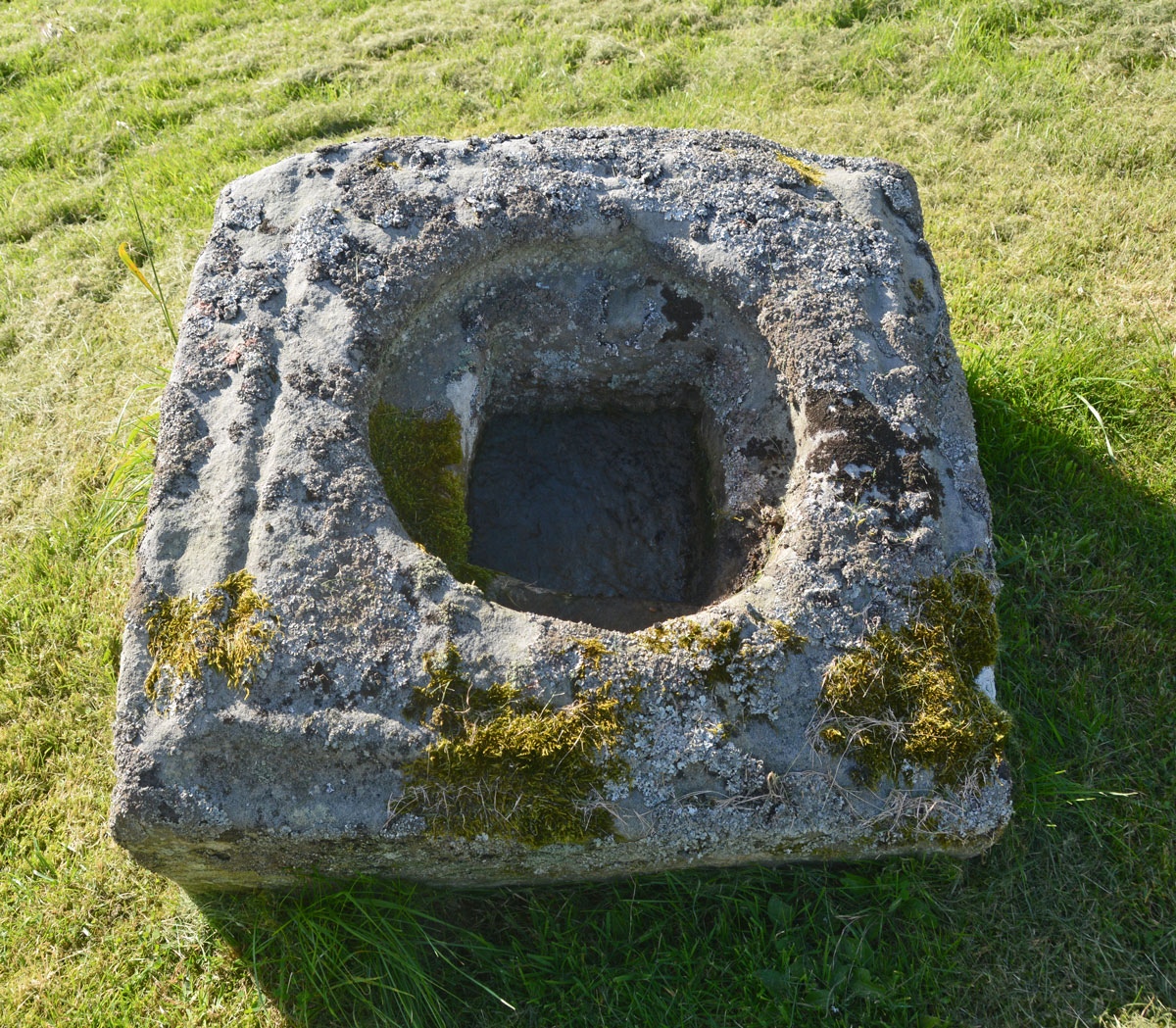
St Cuthbert's Church (Corsenside) submitted by Anne T on 9th Sep 2019. A look down into this 0.8m square socket stone, which has a shallow rectangular socket hole at the bottom of a circular depression. The top of the stone has a single roll moulding around its edge.
(View photo, vote or add a comment)
Log Text: Cross base at St Cuthbert's, Corsenside: This church is a little gem. After having let ourselves in through 2 gates (one by the A68, the other near the church), the views around the church are lovely. The church was open, and we were surprised to find out how old the chancel and sanctuary are. There were some very interesting grave markers inside the church, including one which was possibly a Tudor wayside cross.
The socket stone is exactly where described, and is one of the most ornate we’ve seen. Although a simple rectangle in shape, the rectangular socket stone as a circular depression above it, and in turn a small gully running just inside the top surface.
St Mary the Virgin (Blanchland)
Trip No.149 Entry No.4 Date Added: 12th Sep 2019
Site Type: Ancient Cross
Country: England (Northumberland)
Visited: Yes on 8th Sep 2019. My rating: Condition 3 Ambience 4 Access 4
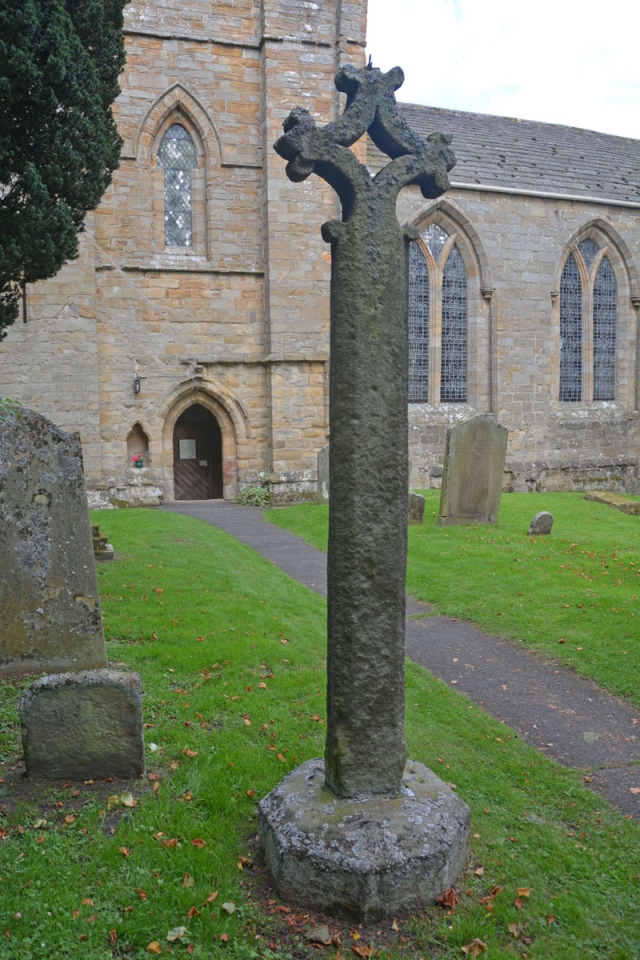
St Mary the Virgin (Blanchland) submitted by Anne T on 10th Sep 2019. Showing where this 13th century cross sits in the churchyard in relation to the west door of the church. We had previously thought this was a relatively modern grave marker, but Pastscape and Historic England both confirm it is a "rare survival of a complete medieval churchyard cross".
(View photo, vote or add a comment)
Log Text: Churchyard Cross, Blanchland: The grid reference given by Pastscape is incorrect; theirs places it on moorland to the north west of the village. The cross is at NY 96598 50408.
Blanchland is a relatively remote, but really lovely medieval village, near the border with County Durham. The site of one of five Premonstratensian Abbeys in north-eastern England, with this church having once formed the centre of worship at the monastery here. Today, only part of the church survives, in a really unusual L-shaped form. After the Reformation, the church was left to become ruined, but was partially restored in the mid-18th century. The current building is formed from the north transept (with the tower at its northern end) and the eastern arm of the medieval Abbey church.
We have been to this church before (and occasionally to the Lord Crewe Arms next door, but more often to the White Monk Tearooms opposite). We thought that this churchyard cross was actually a modern grave marker, as it looks relatively modern, but is what Pastscape and Historic England class as "a rare survival" of a complete medieval churchyard cross.
Inside, the church feels somewhat bare, but there are six interesting grave slabs set into the floor of the north transept. Peter Ryder has recorded these, saying they are "without close local parallels".
To see the eastern external walls of the church, you need to relax in the beer garden of the Lord Crewe Arms!
Bywell Cross
Trip No.150 Entry No.1 Date Added: 12th Sep 2019
Site Type: Ancient Cross
Country: England (Northumberland)
Visited: Yes on 10th Sep 2019. My rating: Condition 3 Ambience 4 Access 5
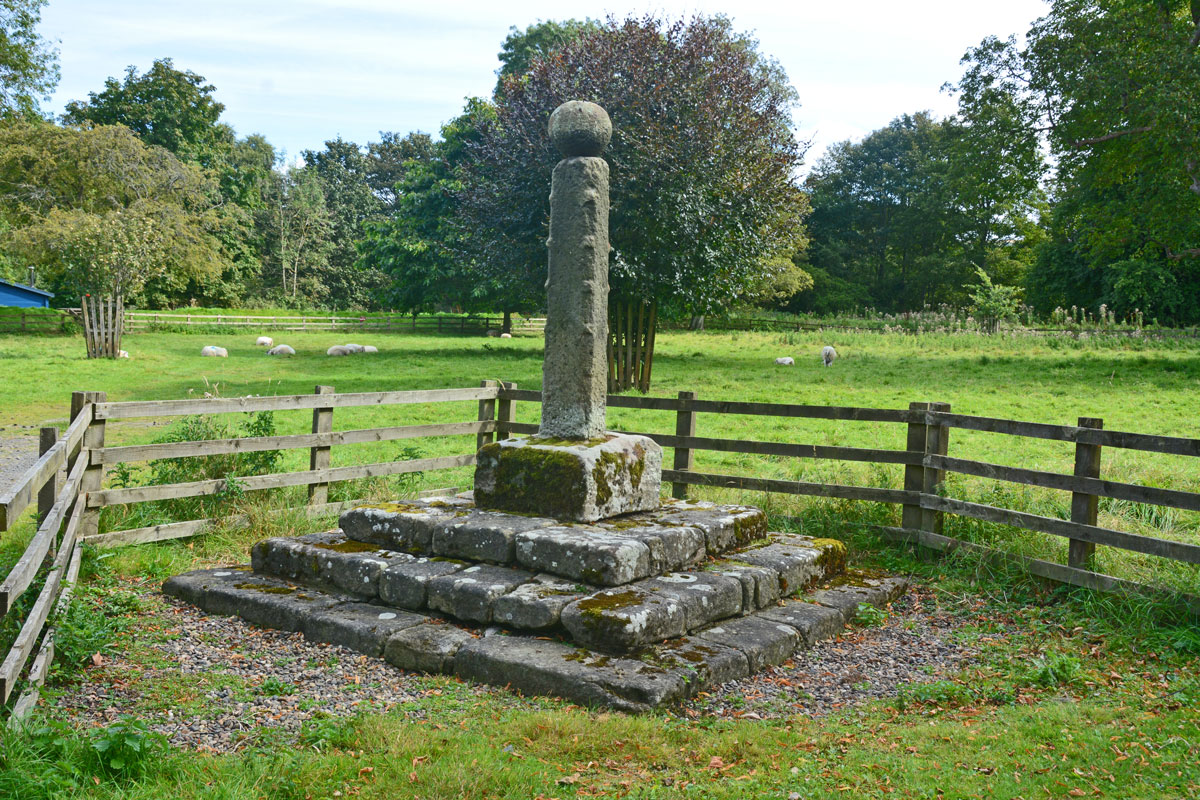
Bywell Cross submitted by Anne T on 12th Sep 2019. First view of the thirteenth century cross, moved from NZ 04876145 to its current location in 1852. It is grade II listed and stands 2.8m tall. The ball finial is dated to 1700.
(View photo, vote or add a comment)
Log Text: Bywell Cross: Considering we live less than a couple of miles from here, and we regularly pop down to walk around here, I've never really stopped to photograph the cross here. Having decided to photograph the medieval cross slabs in St Andrew's church, I got the camera out, only to find another visitor stopped to look at it.
The gentleman told me he'd been doing an annual walk around this area for the last 5(?) years, and was heading off to Ovingham/Ovington next. I decided to come back and photograph the cross after going to St Andrew's, only to find him still there!
This is a very lovely, peaceful spot, with the River Tyne about 50m away. He did eventually wander off after a brief conversation, and I popped into the field to get a photograph of the cross from its eastern side.
St Andrew's Church (Bywell)
Trip No.150 Entry No.2 Date Added: 27th Sep 2019
Site Type: Ancient Cross
Country: England (Northumberland)
Visited: Yes on 10th Sep 2019. My rating: Condition 3 Ambience 4 Access 4
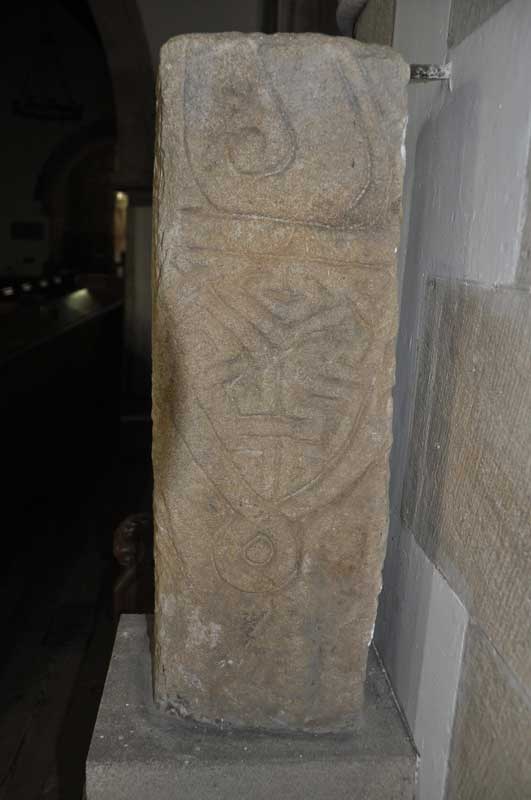
St Andrew's Church (Bywell) submitted by Anne T on 30th Sep 2014. Close up of the second decorated side of the larger fragment, which is the lower part of a cross shaft (Corpus of Anglo-Saxon Stone Sculpture reference: Bywell 01). This face shows the remains of a ring knot and shield shaped pendant.
(View photo, vote or add a comment)
Log Text: St Andrew's Church, Bywell: Living only a few miles from here and having visited, and taken friends there, many times over the years, it seemed remiss not to go down and photograph the wonderful collection of medieval cross slabs built into the fabric of this ancient church. Armed with Peter Ryder's "Medieval Cross Slab Grave Covers in Northumberland, 1: South West Northumberland" from Archaeologia Aeliana, Series 5, XXVIII, we were able to find all the slabs on his list - 27 in total. Brilliant! Really enjoyed this visit.
St Peter's (Bywell)
Trip No.151 Entry No.1 Date Added: 27th Sep 2019
Site Type: Early Christian Sculptured Stone
Country: England (Northumberland)
Visited: Yes on 14th Sep 2019. My rating: Condition 3 Ambience 4 Access 5
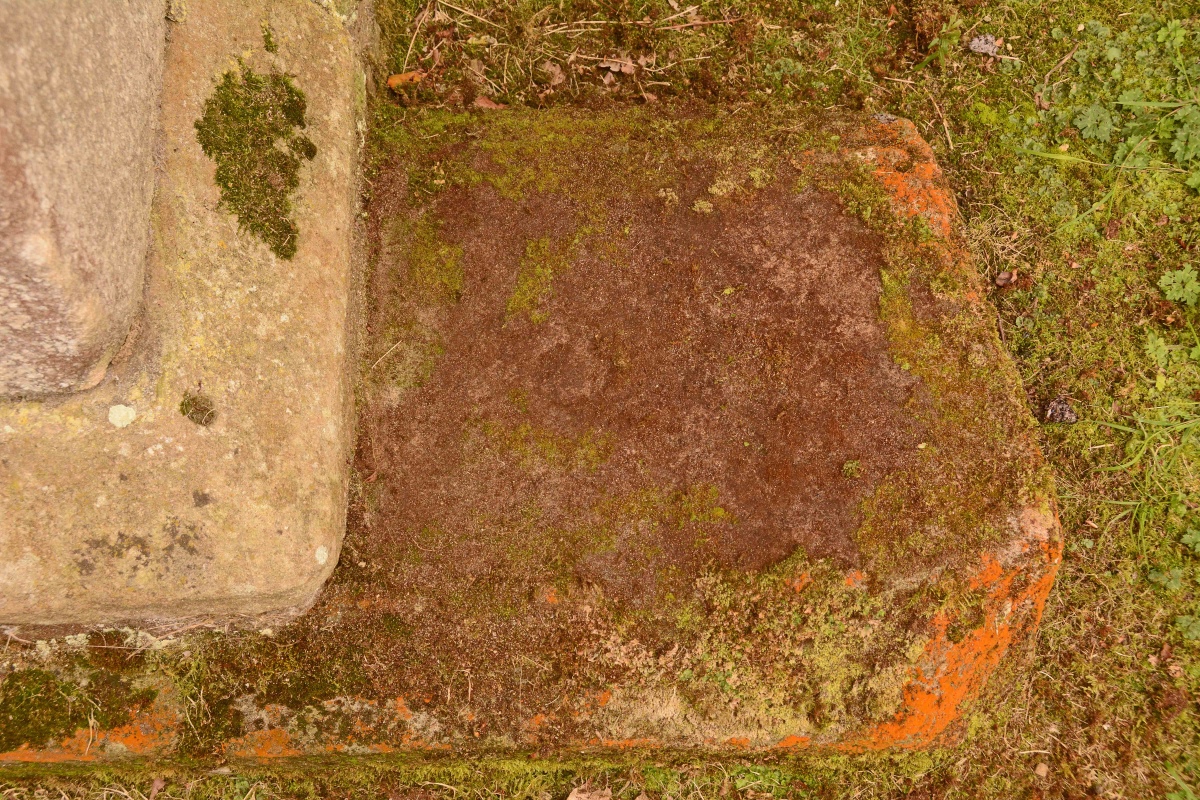
St Peter's (Bywell) submitted by Anne T on 27th Sep 2019. The visible portion of Ryder's Bywell (St Peter's) 13, with a "cross head set within a circle, with sunk lenticular segments between the arms, and a circle at the centre" on the visible section. The small circle can be seen just left of centre of the photograph; the rest of the design is hidden by moss.
(View photo, vote or add a comment)
Log Text: St Peter's, Bywell: Having photographed the cross slabs at St. Andrew's on 10th September 2019, we walked down to St Peter's to try and photograph the slabs Peter Ryder has recorded here. Unfortunately, the church was locked, so we photographed the few slabs on the outside of the building, returning on 14th September, after having ascertained from the vicar the church's opening hours.
This is a really lovely spot, right next to the River Tyne, with the Bywell Village/Market cross and St Andrew's Church, Bywell, with its significant collection of medieval cross slabs and its Anglo Saxon sculptured stones.
Old Viney Museum (Corbridge)
Trip No.151 Entry No.2 Date Added: 16th Sep 2019
Site Type: Sculptured Stone
Country: England (Northumberland)
Visited: Yes on 14th Sep 2019. My rating: Condition 3 Ambience 4 Access 4
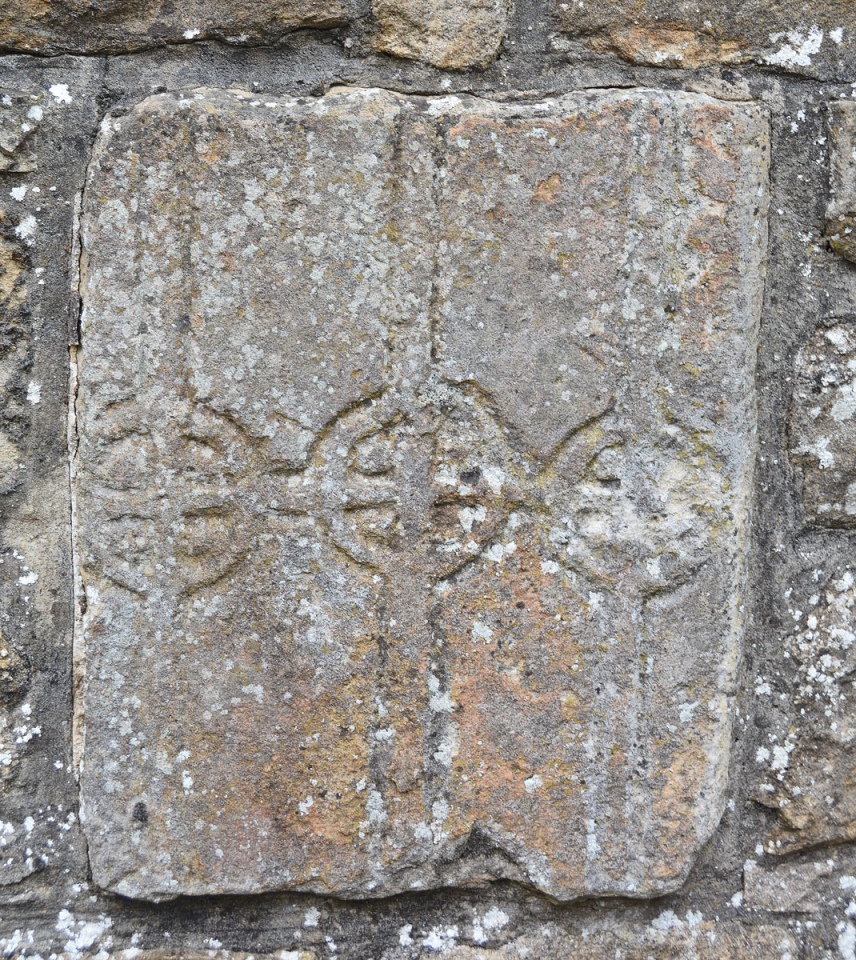
Old Viney Museum (Corbridge) submitted by Anne T on 16th Sep 2019. This stone is built into a wall at the northern side of the cottage, inside the garden. It is recorded as Ryder's Viney 3 and as the Corpus of Anglo Saxon Stone Sculpture's Corbridge 02. It is part carved with three stemmed crosses joined by horizontal arms, and is thought to have been created during the Saxon-Norman overlap period. "The centre of each cross is ringed and within the ring the arms are narrower than the uprights." The Corpus suggests it might have been the side of an altar or...
(View photo, vote or add a comment)
Log Text: The Old Viney Museum, Corbridge: [Photographed the Prince's Street Pant at the corner of the road prior to walking up Appletree Lane.] We had long sought out the location of this museum, where we knew some of the stones recorded on the Corpus of Anglo Saxon Stone Sculpture were built into its walls. Having found Peter Ryder's Cross Slab papers for south west Northumberland, we finally had a street, so went seeking the property, thinking we'd be able to see it from outside.
We were really fortunate to find the owner of the cottage working in his garage, and he was delighted to show us round, leaving us to take photographs. He was also really interested in the documentation I'd taken along (I have since sent him a copy by way of thanks). His father purchased the museum and adjacent school buildings in the 1970s and his family has owned them ever since.
What a treat! I felt so lucky to be welcomed in and to see these stones, which we've wanted to see for at least three years now. Brilliant.
St Peter's Church (Monkwearmouth)
Trip No.152 Entry No.1 Date Added: 25th Sep 2019
Site Type: Early Christian Sculptured Stone
Country: England (Tyne and Wear)
Visited: Yes on 20th Sep 2019. My rating: Condition 3 Ambience 5 Access 4

St Peter's Church (Monkwearmouth) submitted by Anne T on 25th Sep 2019. Displayed at the top of the case in the 'Exhibition Centre' at the eastern end of the north aisle, this is one of a pair of Consecration Crosses, recorded as Monkwearmouth 29 and Monkwearmouth 28. The latter is still in situ in the west gable of the nave, some 42ft above ground, visible only from the interior of the tower, partly beneath a beam. They are both dated to either the 7th century (original date of consecration) or the 11th century (for the rededication of the monastery after its dest...
(View photo, vote or add a comment)
Log Text: St Peter's Church (Monkwearmouth): This trip was made largely thanks to coming across Guy Points' "Gazetteer of Anglo Saxon and Viking Sites: County Durham and Northumberland" (2012), as we hadn't really appreciated what was here. Our intention was to visit St Peter's, go to Sunderland Minster, then walk round Sunderland Museum, although we spent so much time here, we will need to visit the Minster another time.
We were made extremely welcome as soon as we walked through the door, and given a personal tour of the church. Imagine our surprise towards the end, when the guide revealed himself as none other than Guy Points! I was astonished.
Would love to go back and find some of the stones he mentions in his book that we missed on the day, and also have a closer look at the glass and plaster fragments, and sit and enjoy the ambience of the church. Brilliant afternoon!
Sunderland Museum and Winter Gardens
Trip No.152 Entry No.2 Date Added: 26th Sep 2019
Site Type: Museum
Country: England (Tyne and Wear)
Visited: Yes on 20th Sep 2019. My rating: Condition 4 Ambience 4 Access 5
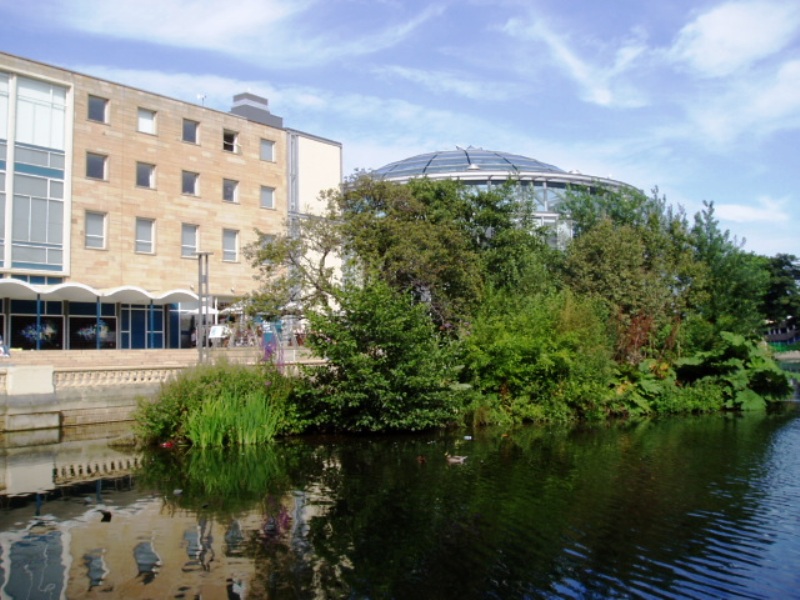
Sunderland Museum and Winter Gardens submitted by durhamnature on 21st Aug 2012. Sunderland Museum, in Mowbray Park
(View photo, vote or add a comment)
Log Text: Sunderland Museum: Despite having been here for many meetings and conferences over the years, I've never wandered around this museum - a series of permanent and special displays in themed rooms off the main corridor leading from the main entrance/gift shop to the cafeteria.
Having spent longer than we thought (well, it was VERY interesting!) at St. Peter's, we knew we didn't have time to go the Minster to see their stones collection before shutting to visitors at 2.30pm, so came here instead (it was supposed to be our third, and last, stop of the afternoon).
We focused mainly on the Secrets of the Past Exhibition on the ground floor, which has some of the Anglo Saxon stone fragments recorded by the Corpus of Anglo Saxon Stone Sculpture. Not all of them (mostly the smallest) fragments were on display, so I have asked if it's possible for us to see, and photograph, these.
There were also prehistoric cists with grave goods, stone axes, jewellery, and other artefacts on display.
The museum seemed largely deserted at this time of day, apart from a few people coming down the staircase at the rear of this exhibition hall.
We enjoyed a rather large, and tasty, lunch in the cafeteria before leaving.
St John's Cross (Canongate)
Trip No.153 Entry No.1 Date Added: 9th Oct 2019
Site Type: Ancient Cross
Country: Scotland (Midlothian)
Visited: Yes on 1st Oct 2019. My rating: Condition 2 Ambience 3 Access 4

St John's Cross (Canongate) submitted by Anne T on 9th Oct 2019. The location of the old St John's Cross (now said to be outside Canongate Kirk). Whilst the location is said to be marked by a white St John's Cross, the paint had almost been worn away, and if I hadn't seen similar circles of pavers in other locations, might not have recognised the spot. Having spotted the circle, a closer look around revealed the plaque describing the cross on an adjacent wall in deep shadow on the south side of Canongate.
(View photo, vote or add a comment)
Log Text: St John's Cross, Edinburgh (site of): The site of this cross was one of the clues (no. 6) on the 'Treasure Trail' map for the Old Town Trail. The markings for this cross were very faint indeed. I only recognised the spot by the circle of bricks in the road, as I’d seen similar features before. There is a plaque on the wall nearby.
From the funny, small brass plates in the road and pavement just to the west, at the junction of High Street and Canongate (W-E) and Jeffrey Street-Saint Mary's Street to the east, the cross would have been located just outside the old city walls.
Whilst I've been to Edinburgh on a number of occasions, I have never walked down Canongate before, and it was a great spot for discovering 'old things and old sites'.
Canongate Mercat Cross
Trip No.153 Entry No.2 Date Added: 9th Oct 2019
Site Type: Ancient Cross
Country: Scotland (Midlothian)
Visited: Yes on 1st Oct 2019. My rating: Condition 3 Ambience 4 Access 4
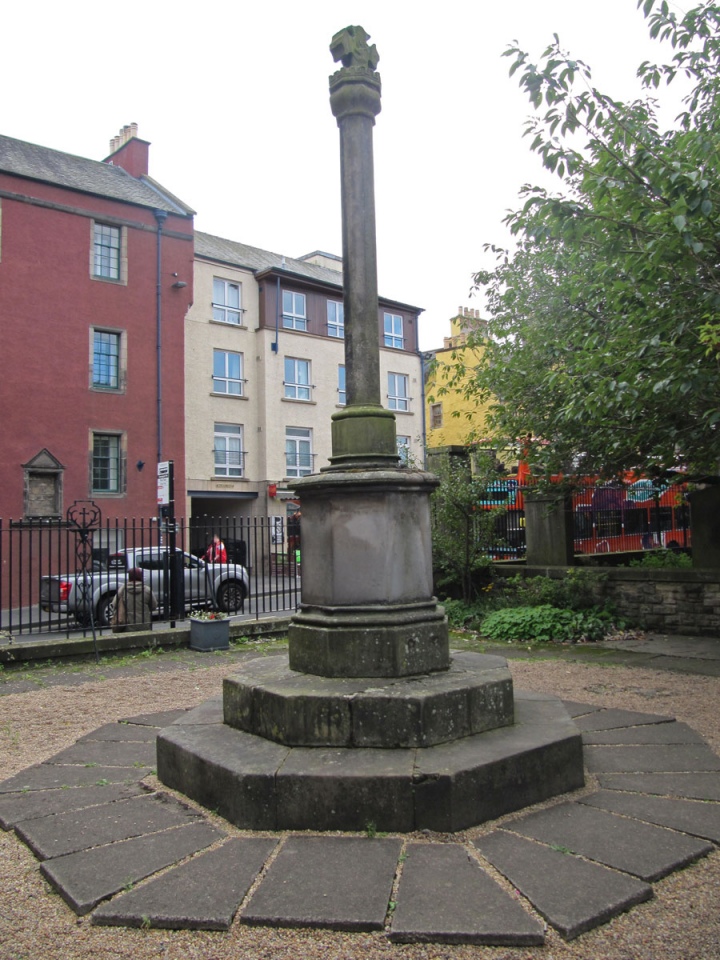
Canongate Mercat Cross submitted by Anne T on 9th Oct 2019. Standing in the NE corner of the courtyard, looking SW to Canongate. The cross looks modern, but then Canmore (and British Listed Buildings) tell us that the octagonal cross shaft is original; the rest are 'modern' replacements.
(View photo, vote or add a comment)
Log Text: Canongate Mercat Cross: Again, we found this cross by chance by following the clues on the "Old Edinburgh Town" Treasure Trail, whilst looking for the answers to two clues within the churchyard. I am sure I annoyed my friend by stopping to photograph all the sites of ancient crosses and wells that we came across, as our 2 hour 'trail' took 4 hours (although this included a coffee and cake stop, too).
Never really having explored Edinburgh Old Town, I was really surprised to find out how much, and how historic, Canongate and surrounding area is.
Girth Cross (Canongate)
Trip No.153 Entry No.4 Date Added: 9th Oct 2019
Site Type: Ancient Cross
Country: Scotland (Midlothian)
Visited: Yes on 1st Oct 2019. My rating: Condition -1 Ambience 3 Access 5

Girth Cross (Canongate) submitted by Anne T on 9th Oct 2019. Standing on the pedestrian island at the western side of the roundabout, I had to wait for ages to get a view without traffic whizzing by on either side. The outer wall Scottish Parliament building is on the left hand side of the photograph. This view looks west up Canongate. If I hadn't have known, from our Treasure Trail clues, that this was the site of the cross, I would have passed it by, but it marks the western limit of the Girth of Holyrood, the largest sanctuary in Scotland, and the las...
(View photo, vote or add a comment)
Log Text: Site of the Girth Cross, Canongate: Again, we picked this location up from the Treasure Trail, after Clue 15, there is a ‘Did you know?’ box which reads: “Where Canongate meets Abbeyhill look out for the circle of cobbles. This is the site of the ‘Old Girth Cross’ where proclamations and executions took place. In 1600 Lady Warriston was beheaded by guillotine for conspiring to murder her abusive husband”.
This site is at a very busy road junction, west of Holyrood Palace, and at the eastern end of Canongate, where Canongate meets Abbeyhill, Abbey Strand and Horse Wynd.
Not much to see really, apart from a circle of grey pavers
St Nicholas's Cathedral (Newcastle)
Trip No.154 Entry No.2 Date Added: 21st Oct 2019
Site Type: Ancient Cross
Country: England (Tyne and Wear)
Visited: Yes on 16th Oct 2019. My rating: Condition 2 Ambience 2 Access 4
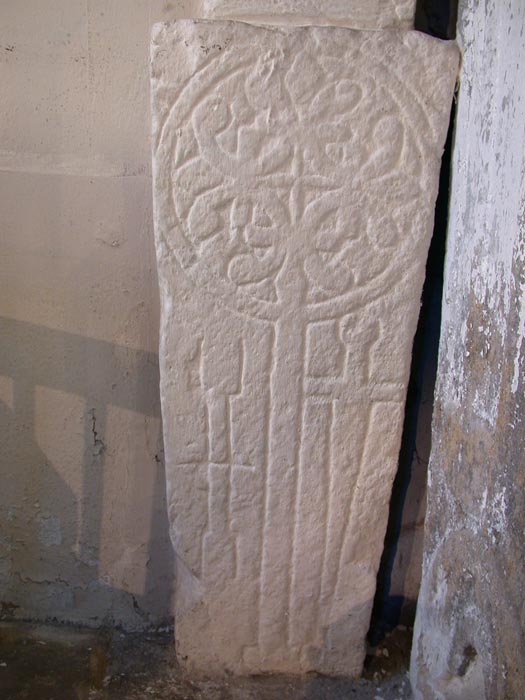
St Nicholas's Cathedral (Newcastle) submitted by nicoladidsbury on 13th Aug 2005. Elaborate Cross Slab, featuring two vertical sword shafts, similar to much smaller cross slabs found built into the fabric of the Norman wall in the ancient church at Old Ireby
(View photo, vote or add a comment)
Log Text: St Nicholas's Cathedral, Newcastle: I'd arranged with one of the vergers, James, to meet him at noon on 16th October to be allowed down into the vault below the south transept to see the cross slabs now stored down there.
The space is now used as a chair store, with a scissor lift at its southern end, and a larger trap door which comes up underneath the piano in the south transept.
Access was through a trap door, with a vertical ladder which started a couple of feet below the floor of the transept, so I bottled out of climbing down, and sent Andrew down with the camera.
He reported that it was really interesting seeing this space, with its barrel vaulted ceiling, but the slabs had all been stored against a wall underneath a pile of tables and other general items. What he could see looked very worn, which is presumably why they were stored down here in the first place. The stones must have deteriorated alarmingly in the 100 years or so since they were drawn by C.C. Hodges.
Disappointing. They were tuning the organ whilst we were there, which was interesting. The open trap door caused interest from other visitors to the Cathedral who wanted to look down. I volunteered to stop anyone falling down the trapdoor, so got to talk to quite a few people who were interesting in seeing this space.
Borrowdale Stone Monument
Trip No.155 Entry No.1 Date Added: 15th Jan 2020
Site Type: Standing Stones
Country: England (Cumbria)
Visited: Yes on 12th Jan 2020. My rating: Condition 3 Ambience 4 Access 3
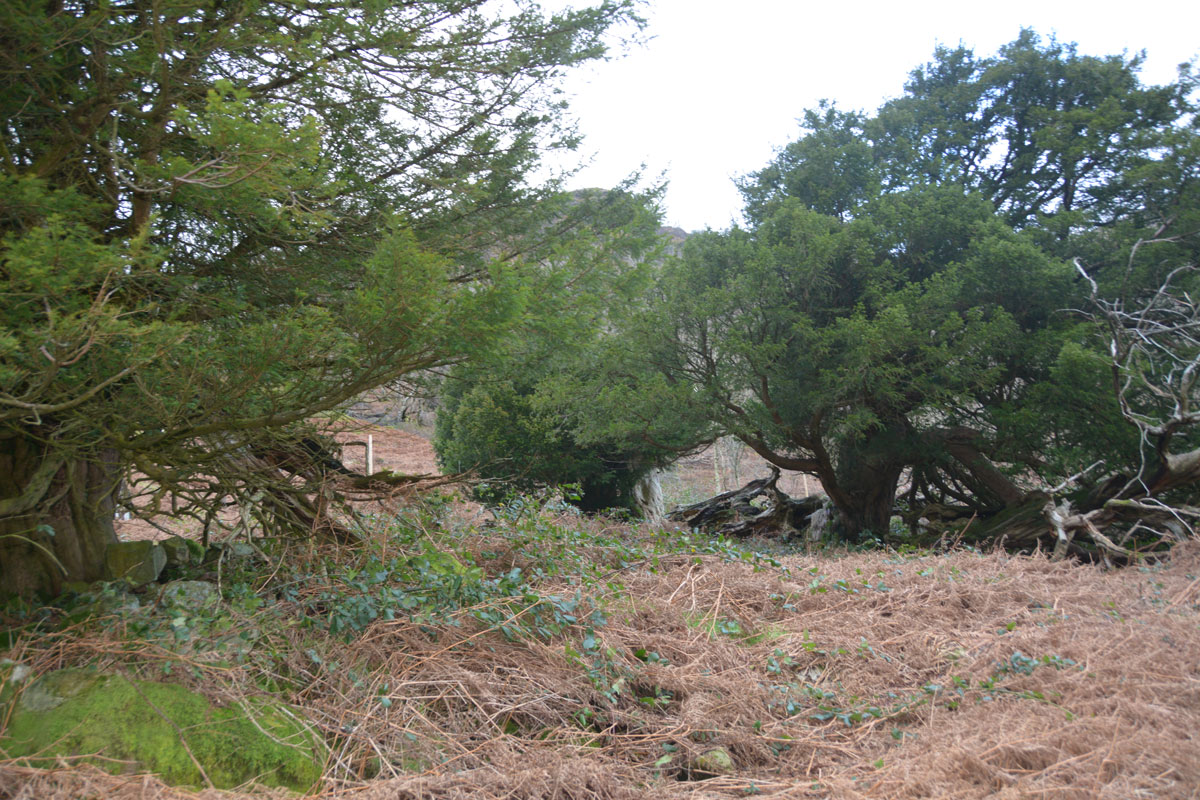
Borrowdale Stone Monument submitted by Anne T on 15th Jan 2020. Some of the smaller boulders have been cleared and piled up around the base of these ancient yew trees. Certainly very impressive trees and very old indeed. Well worth a visit. Photograph by Andrew T.
(View photo, vote or add a comment)
Log Text: Borrowdale Yews and the possible stone monument: Our first trip out for several months, and a way of escaping the windy and wet weather here in Northumberland. However, we arrived in a Cumbria that had experienced very heavy rain over recent days, and the small stream were swollen and many of the roads were flooded, although still passable.
We parked in the small car park near Seathwaite Farm, which is also a camping site and walked through the fields to the two bridges crossing the river(s). There are also a number of other streams to be crossed between here and the yew tree enclosure; at times of dry weather these would be easy to cross. On this occasion, a bit of balancing on convenient ‘stepping stones’ was in order!
The slope up to the yew tree enclosure was very slippery, so I sent Andrew up with the camera to explore. He came back saying the stones are definitely aligned in what seems to be a row, although I remained very sceptical, as there are a huge number of other boulders (large and small) on the hillside. Looking at the site from the south of river, by the car park, there seems to be the remains of the lower half of a double stone circle to the south west of the yew tree enclosure, although this could also just be coincidence.
This area was very heavily mined for graphite from 1555 onwards, and the remains of some of the industrial buildings can still be seen.
Sorry, but I remain unconvinced this is a stone row or alignment – there were so many other short rows of seemingly aligned stones on the hillside, this seemed like coincidence to me.
Bowder Stone
Trip No.155 Entry No.2 Date Added: 15th Jan 2020
Site Type: Natural Stone / Erratic / Other Natural Feature
Country: England (Cumbria)
Visited: Yes on 12th Jan 2020. My rating: Condition 3 Ambience 4 Access 4
Bowder Stone submitted by maigo on 25th Jun 2013. May2009
(View photo, vote or add a comment)
Log Text: The Bowder Stone, Borrowdale: We parked in the car park (there is a small charge) and walked the quarter of a mile to this enormous boulder. The last time we came here, some time ago, we walked through the quarry and I remember photographing all the old tree roots emerging from the rock and forming strange and complex patterns. Not so now, a recent path runs uphill, following the western side of the boundary for the quarry.
As usual, there was a party of young people, complete with mattresses, bouldering underneath the overhang. It was amusing to stand and watch them, although some of the tumbles looked a bit painful.
Andrew headed up the ladder to the platform at the top, whilst I wandered round the other side of the stone, a megalith catching my eye.
Pocklington's Druid Stone
Trip No.155 Entry No.3 Date Added: 15th Jan 2020
Site Type: Modern Stone Circle etc
Country: England (Cumbria)
Visited: Yes on 12th Jan 2020. My rating: Condition 4 Ambience 4 Access 4
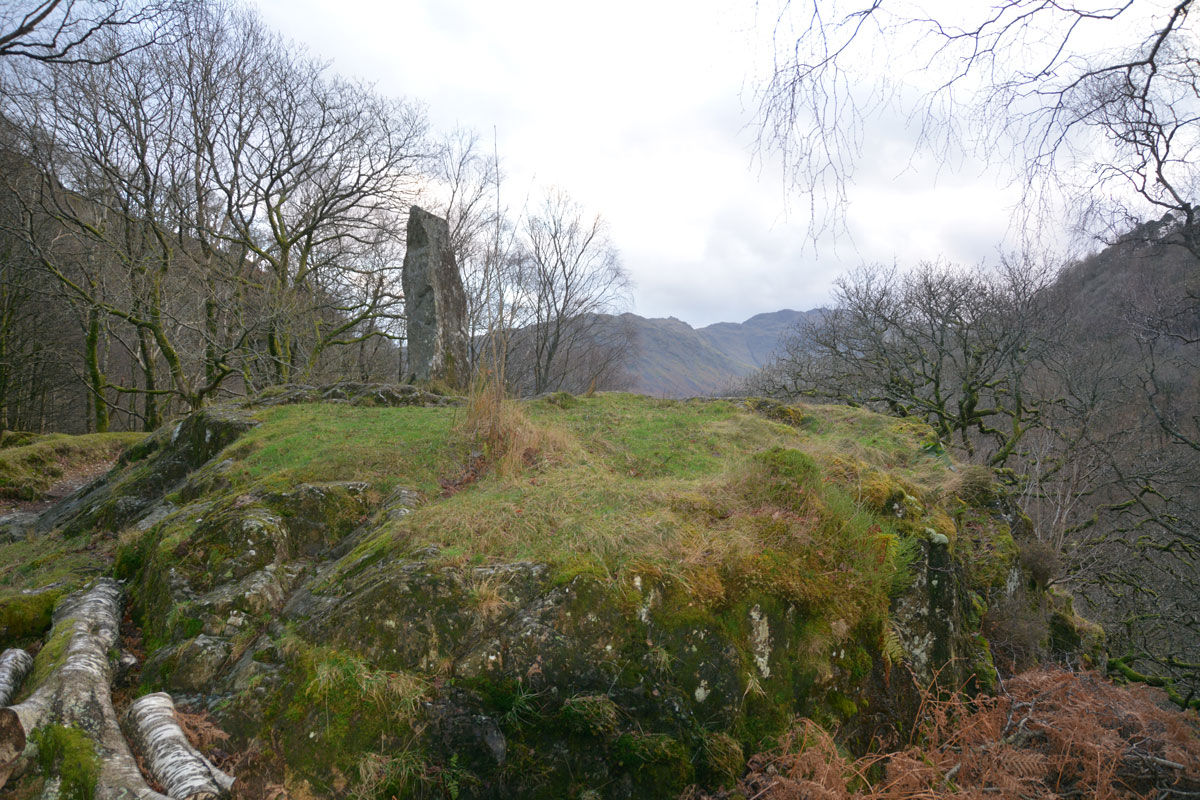
Pocklington's Druid Stone submitted by Anne T on 15th Jan 2020. Pocklington's Druid Stone, a relatively modern megalith, having been erected here in around 1778, stands on top of a rocky outcrop just to the south of the Bowder Stone. This view looks south, with the B5289 and the River Derwent below.
(View photo, vote or add a comment)
Log Text: Pockington's Druid Stone at the Bowder Stone: A short distance from the Bowder Stone, almost hidden from sight by a small cottage, this 'modern' monolith stands on top of a rocky outcrop high above the road below. At first, I thought it might be a memorial, as there appeared to be writing on the stone. Getting closer, the 'writing' was just striations on the stone.
St Hilda's Church (Hartlepool)
Trip No.156 Entry No.1 Date Added: 11th Feb 2020
Site Type: Early Christian Sculptured Stone
Country: England (County Durham)
Visited: Yes on 5th Feb 2020. My rating: Condition 4 Ambience 4 Access 4

St Hilda's Church (Hartlepool) submitted by Anne T on 11th Feb 2020. The impressive Hildthryth namestone, on display on the eastern wall of the St Nicolas Chapel, on the southern side of the sanctuary. Also recorded as Hartlepool 01 on the Corpus of Anglo Saxon Stone Sculpture. The stone measures 27cms high, 29cms wide and 11cms deep. Poinds tells us: "The west face is decorated with a plain border which surrounds a large cross whose centre is square rather than circular and whose cross arms are square ended. The lettering on each side of the upper vertical arm o...
(View photo, vote or add a comment)
Log Text: St Hilda's, the Headland, Hartlepool: What a magnificent building, with its collection of huge flying buttresses supporting the external walls of the tower. Inside, it is more like a mini-cathedral than a parish church.
We had the pleasure of being greeted by Mr. John Hogg, parishioner with responsibility for Visitor Ministry, and the most knowledgeable guide we could wish to meet.
We spent almost the full hour and a half looking round the church, the fragments in the Brus Chapel and the old south door, plus admiring the Hildthryth stone in the St Nicholas Chapel. I just wish the opening hours of the church had been longer, as I was really interested to see the display boards located around the south and north walls of the nave.
The altar rails are also interesting, as they are made of 1,000 year old oak (but do look Victorian!). A real gem, and well worth a visit.
St Hilda's Wayside Cross (Hartlepool)
Trip No.156 Entry No.2 Date Added: 11th Feb 2020
Site Type: Ancient Cross
Country: England (County Durham)
Visited: Yes on 5th Feb 2020. My rating: Condition 3 Ambience 4 Access 5

St Hilda's Wayside Cross (Hartlepool) submitted by Anne T on 11th Feb 2020. Looking down into the socket hole of the cross base, which is about 20cms square, and 5-6cms deep. The remains of old lead can be seen around the edges of the socket hole, indicating it once held a cross shaft or other fragment.
(View photo, vote or add a comment)
Log Text: Wayside Cross base outside St Hilda's Church: I spotted this more by accident than design, and photographed it, before we rushed off to the old Gray Art Gallery and Museum site to try and track down its old site. We couldn't find it where the grid reference placed it. A worker from the now office building, William Gray House, which now houses the Council and Tees Archaeology, told us the art gallery had closed in 1995 although people still came looking for it. He had no knowledge of a cross base in the grounds.
It wasn't until I got home and was doing some research that I came across the HE entry, which we hadn't seen earlier, which told us the cross base had been moved to this location in 1997.
St Mary Magdalene (Hart)
Trip No.156 Entry No.4 Date Added: 12th Feb 2020
Site Type: Early Christian Sculptured Stone
Country: England (County Durham)
Visited: Yes on 5th Feb 2020. My rating: Condition 3 Ambience 4 Access 5
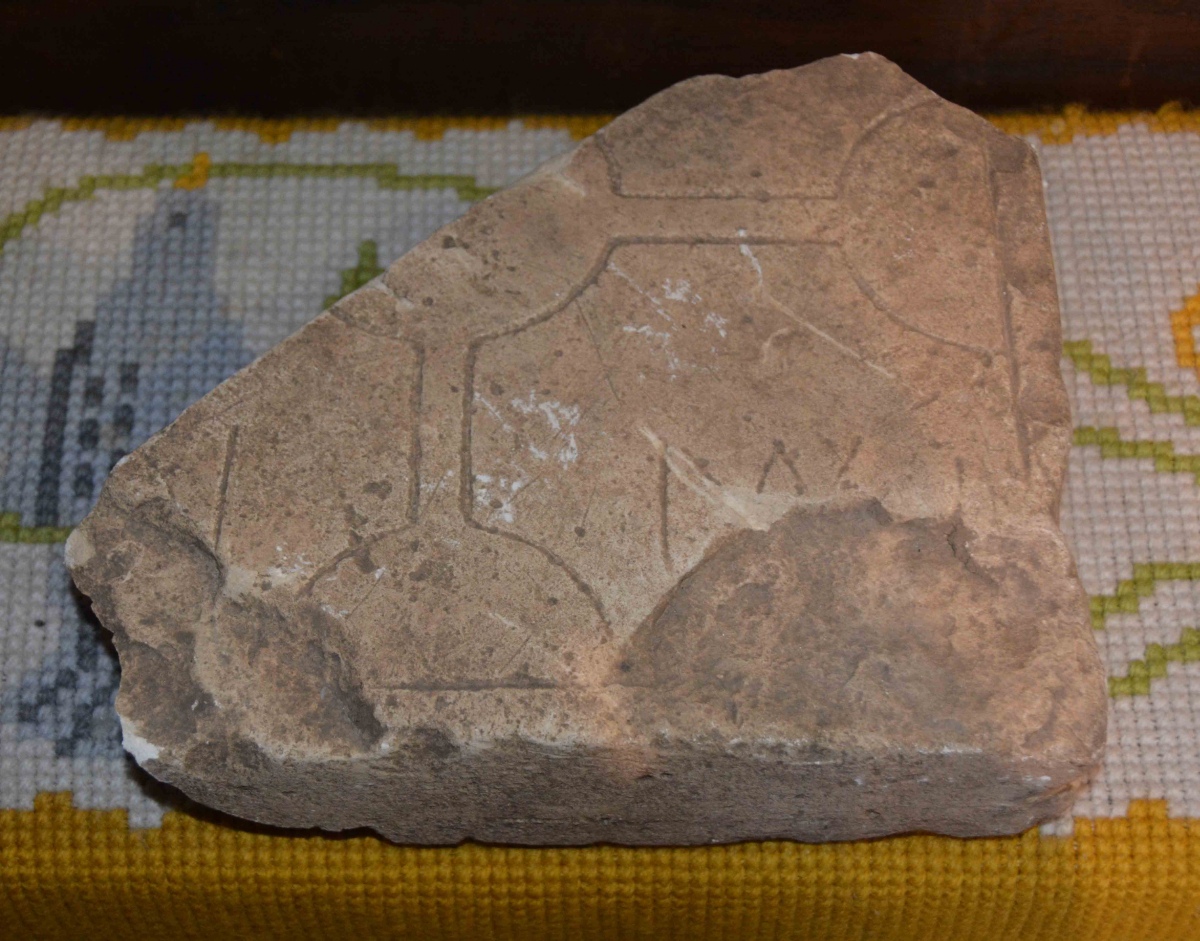
St Mary Magdalene (Hart) submitted by Anne T on 12th Feb 2020. This fragment of namestone/pillow stone is not recorded by either the Corpus of Anglo Saxon Stone Sculpture or Guy Poinds in his Gazetteer of Anglo Saxon and Viking Sites: Northumberland and County Durham. Fragments of what look like runic writing can be seen in the bottom left hand quadrant, and it is a much better example than the one in the Museum of Hartlepool. I have emailed the vicar asking if she has any information about where and when it was found.
(View photo, vote or add a comment)
Log Text: St Mary Magdalene, Hart: From the exterior of the building, I did not expect to 'walk back in time' into this splendid parish church. Such a sense of history, and what fragments of sculptured stones - a real treat. The church was only open for an hour on Wednesdays, between 3pm and 4pm at this time of year, essentially for quiet prayer, but the time flew, and we kept the church warden longer than intended. I would have loved to have spent another hour here, just enjoying the atmosphere.
Edinburgh Runestone
Trip No.157 Entry No.4 Date Added: 20th Feb 2020
Site Type: Carving
Country: Scotland (Midlothian)
Visited: Yes on 18th Feb 2020. My rating: Condition 3 Access 4
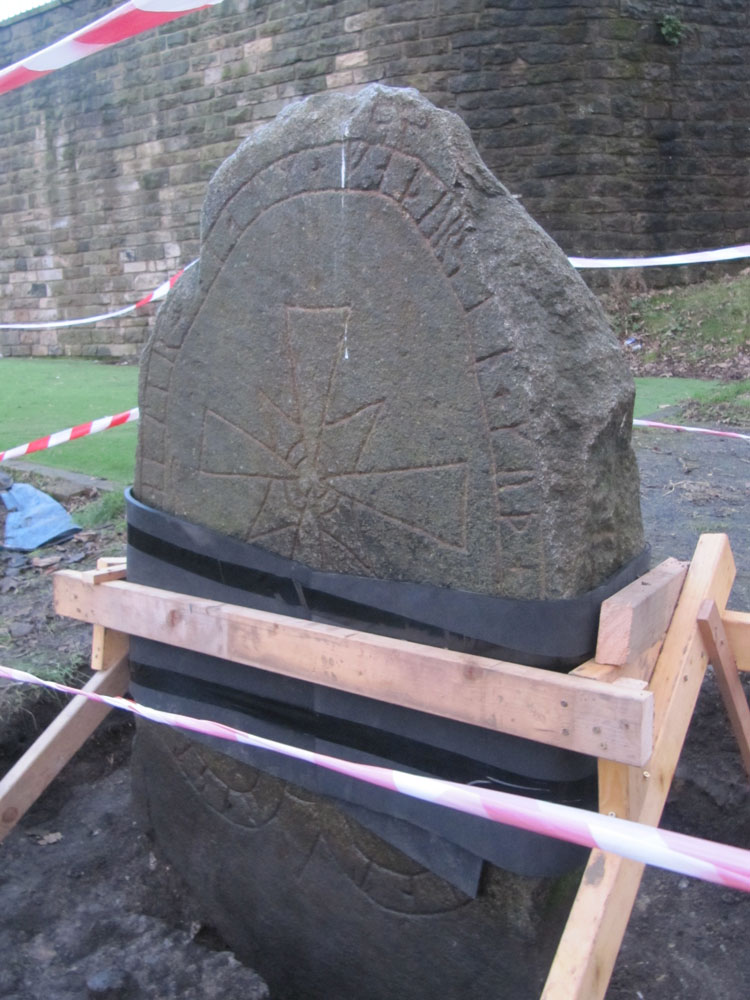
Edinburgh Runestone submitted by Anne T on 7th Jan 2018. The Runestone seen by clambering up the steep muddy track from Princes Street Gardens, just below the Castle Esplanade. The runes read: ""Ari engraved this stone in memory of Hialm his father. God help his soul."
(View photo, vote or add a comment)
Log Text: Edinburgh Runestone, George's Square: A friend very kindly told me this stone has now been relocated, although it is still in the process of being bedded into its new spot, with the concrete shuttering still around its base.
The red cross on the eastern narrow side of the stone has now been picked out in red paint. The plain, southern side, is presumably to be hidden by shrubs once the bed is replanted.
